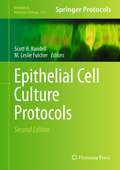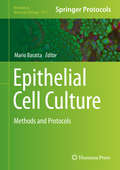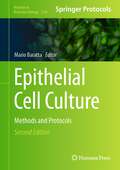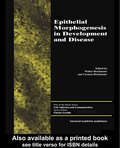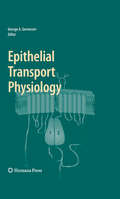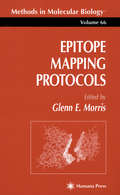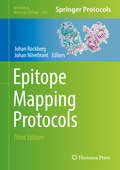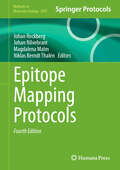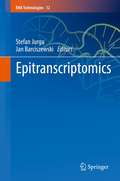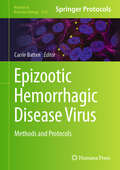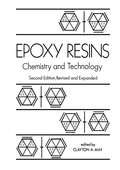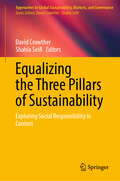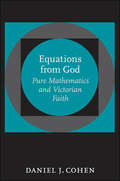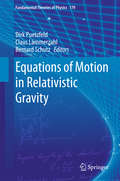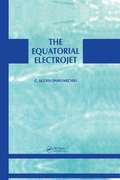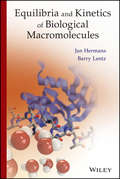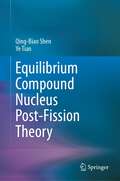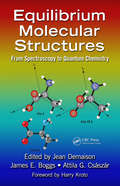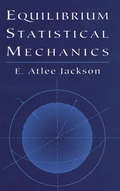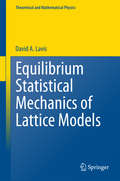- Table View
- List View
Epitaxy of Semiconductors: Physics and Fabrication of Heterostructures (Graduate Texts in Physics #4)
by Udo W. PohlThe extended and revised edition of this textbook provides essential information for a comprehensive upper-level graduate course on the crystalline growth of semiconductor heterostructures. Heteroepitaxy is the basis of today’s advanced electronic and optoelectronic devices, and it is considered one of the most important fields in materials research and nanotechnology. The book discusses the structural and electronic properties of strained epitaxial layers, the thermodynamics and kinetics of layer growth, and it describes the major growth techniques: metalorganic vapor-phase epitaxy, molecular-beam epitaxy, and liquid-phase epitaxy. It also examines in detail cubic and hexagonal semiconductors, strain relaxation by misfit dislocations, strain and confinement effects on electronic states, surface structures, and processes during nucleation and growth. Requiring only minimal knowledge of solid-state physics, it provides natural sciences, materials science and electrical engineering students and their lecturers elementary introductions to the theory and practice of epitaxial growth, supported by references and over 300 detailed illustrations. In this second edition, many topics have been extended and treated in more detail, e.g. in situ growth monitoring, application of surfactants, properties of dislocations and defects in organic crystals, and special growth techniques like vapor-liquid-solid growth of nanowires and selective-area epitaxy.
Epithelial Cell Culture Protocols
by M. Leslie Fulcher Scott H. RandellFascinating biology occurs at epithelial interfaces, whether between organism and environment or within body compartments, and many diseases inflicting huge personal and societal burdens result from dysfunction of epithelial systems, e.g., carcinomas. Epithelial cell cultures have been an integral and crucial part of the biomedical research enterprise, adding unique capabilities and enabling mechanistic approaches. In the past decade there have been many research advances, such as directed differentiation of embryonic stem cells and induced pluripotent stem cells, robotic high throughput screening, whole genome siRNA and shRNA libraries, massively parallel sequencing at low cost, identification of somatic stem cells in key organs, to name a few. Epithelial Cell Culture Protocols, Second Edition provides a cross section of up-to-date culture protocols for the most heavily studied cell systems and featured supporting technologies. Written in the successful Methods in Molecular BiologyTM series format, chapters include introductions to their respective topics, lists of the necessary materials and reagents, step-by-step, readily reproducible protocols, and notes on troubleshooting and avoiding known pitfalls. Authoritative and easily accessible, Epithelial Cell Culture Protocols, Second Edition will serve outstanding investigators with the best possible information for the advancement of biomedical science.
Epithelial Cell Culture: Methods and Protocols (Methods in Molecular Biology #1817)
by Mario BarattaThis detailed book explores the most current techniques to study systems and epithelial cell culture. Beginning with an overview, the volume then continues to detail systems that seek to mimic the three-dimensional organization, epithelial cells from different organs, gastrointestinal system, thyroid, salivary gland, ovary, mammary gland, and olfactory epithelial tissue. Cell culture is a fundamental technique in both medical research and drug discovery and two-dimensional (2D) culture has been the preferred method, due to the ease with which cell monolayers can be induced to proliferate on planar surfaces. The book propose several functional assay useful to test cell activities. Further, The past decades have witnessed significant efforts toward the development of three-dimensional (3D) cell cultures. Today, 3D cell cultures are emerging not only as a new tool in early drug discovery, but also as potential therapeutics to treat disease. Written for the highly successful Methods in Molecular Biology series, chapters include the kind of detail and key implementation advice that leads to excellent results in the lab.
Epithelial Cell Culture: Methods and Protocols (Methods in Molecular Biology #2749)
by Mario BarattaBack Cover Copy This second edition volume expands on the previous edition with in-depth discussions on the rapid advancements in epithelial cell biology, and the cutting-edge research and techniques used by researchers in the field. The chapters in this book cover topics such as detailed methodologies applicable to epithelial cells derived from primates, pigs, bovines, and laboratory animals; the manipulation and differentiation of epithelial cells; and epithelial cell models in the gastroenteric system in human medicine and nutrition. Written in the highly successful Methods in Molecular Biology series format, chapters include introductions to their respective topics, lists of the necessary materials and reagents, step-by-step, readily reproducible laboratory protocols, and tips on troubleshooting and avoiding known pitfalls.Comprehensive and cutting-edge, Epithelial Cell Culture: Methods and Protocols, Second Edition is a valuable resource for researchers in the scientific community, educators, and students who are interested in unraveling the complexities of epithelial cell biology, cultivating curiosity, and inspiring the next generation of groundbreaking research.
Epithelial Morphogenesis in Development and Disease
by Walter BirchmeierBringing together a series of articles on the structural, functional, and developmental characteristics of epithelia, this volume represents a timely and valuable contribution to a growing field of study.
Epithelial Transport Physiology
by George A. GerencserThe scope of this book was preempted and precipitated by the pioneering studies of Ussing and co-workers. The first phase of the phenomenological description of the cell as a black box has been followed by studies of cellular mechanisms, the interplay of the different transport components, and the mechanisms of regulation which will be covered in the individual chapters. For the individual epithelia transport schemes that have been proposed, I think it is appropriate to take pause and search for elements common to several epithelia. This aspect triggered the common theme idea for this book, and in fact the various chapters emphasize that the functional transporter components, expressed in the various epithelia, are not infinite in number, but they occur in epithelia which are separated in evolution by several hundred million years.
Epitope Mapping Protocols
by Glenn E. MorrisEpitope Mapping Protocols offers more than thirty protocols for antibody production and mapping-all described in detail by leading experts and illustrated by proven examples from their own work. The methods range from those that use (or can use) whole, native antigens to those that use peptides and peptide libraries and those that require antigen expressed from recombinant DNA. A method for T-cell epitopes, instructions on using "natural" variants or mutants, and techniques for producing panels of antibodies for epitope mapping are also included.
Epitope Mapping Protocols (Methods in Molecular Biology #1785)
by Johan Rockberg Johan NilvebrantThis third edition volume expands on the previous editions with more detailed research on the characterization of antibody antigen interactions between different users with different requirements. The chapters in this book are divided into four parts: Part One looks at the entire native antigen and covers traditional structural biology techniques such as nuclear magnetic resonance and x-ray crystallography. Part Two talks about protein fragments derived from antigens, and discusses binding regions within antigen sequence using bacterial surface display and ELISA, for example. Part Three describes the use of surface plasmon resonance spectroscopy and biolayer interferometry, and Part Four highlights methods used to identify new antigens and assess antibody cross-reactivity. Written in the highly successful Methods in Molecular Biology series format, chapters include introductions to their respective topics, lists of the necessary materials and reagents, step-by-step, readily reproducible laboratory protocols, and tips on troubleshooting and avoiding known pitfalls.Thorough and cutting-edge, Epitope Mapping Protocols, Third Edition is a valuable resource for anyone interested in furthering their research in this expanding field.
Epitope Mapping Protocols (Methods in Molecular Biology #2937)
by Johan Rockberg Johan Nilvebrant Magdalena Malm Niklas Berndt ThalénThis detailed new edition explores methodologies for the characterization of antibody-antigen interactions tailored to different applications and requirements. Beginning with an overview of key concepts and definitions related to antibody epitopes, the book continues with sections on structural biology methods, display technologies to analyze libraries of proteins or protein arrays, techniques based on protein labeling, as well as computational approaches and binding assays that rely on binding interactions or competition. Written for the highly successful Methods in Molecular Biology series, chapters include introductions to their respective topics, lists of the necessary materials and reagents, step-by-step and readily reproducible laboratory protocols, and tips on troubleshooting and avoiding known pitfalls. Authoritative and up-to-date, Epitope Mapping Protocols, Fourth Edition serves as an ideal resource for scientists from a wide range of fields involved in critical antibody research. Chapter 19 is available open access under a Creative Commons Attribution 4.0 International License via link.springer.com.
Epitranscriptomics (RNA Technologies #12)
by Jan Barciszewski Stefan JurgaThis book reviews a novel and exciting field of cellular and molecular biology called epitranscriptomics, which focuses on changes in an organism’s cells resulting from the posttranscriptional modification of cellular RNA. RNA-binding proteins (RBPs) play a crucial role in these posttranscriptional modifications and also support several cellular processes necessary for maintaining RNA homeostasis. Exploring the mechanisms underlying RNA modifications and RBP function is an emerging area of biomedical research, taking the study of gene regulation a step beyond epigenetics. This book reveals that the RNA molecule is not just an information-carrying molecule with some secondary structures. Accordingly, how RNA is modified, regulated, packaged, and controlled is an important aspect. Leading experts address questions such as where the over 170 distinct posttranscriptional RNA modifications are located on the genome, what percentage of mRNAs and noncoding RNAs these modifications include, and how an RNA modification impacts a person’s biology. In closing, the book reviews the role of RNA modifications and RBPs in a variety of diseases and their pathogenesis. Addressing some of the most exciting challenges in epitranscriptomics, this book provides a valuable and engaging resource for researchers in academia and industry studying the phenomena of RNA modification.
Epizootic Hemorrhagic Disease Virus: Methods and Protocols (Methods in Molecular Biology #2838)
by Carrie BattenThis volume provides detailed methods to support fast and reliable diagnosis, surveillance and control of Epizootic Haemorrhagic disease virus (EHDV), with the aim of facilitating and promoting further research into this understudied Orbivirus. Chapters guide readers through methods to enable the characterization of EHDV in vitro and in vivo. Written in the highly successful Methods in Molecular Biology series format, chapters include introductions to their respective topics, lists of the necessary materials and reagents, step-by-step, readily reproducible laboratory protocols, and key tips on troubleshooting and avoiding known pitfalls. Authoritative and cutting-edge, Epizootic Hemorrhagic Disease Virus: Methods and Protocols aims to be a useful up-to-date reference work for researchers currently in the field and to those entering the field.
Epoxidations and Hydroperoxidations of α,β-Unsaturated Ketones
by Corinna ReisingerCorinna Reisinger has developed a new organocatalytic asymmetric epoxidation of cyclic and acyclic α,β-unsaturated ketones. In this thesis, Corinna documents her methodology, using primary amine salts as catalysts, and hydrogen peroxide as an inexpensive and environmentally benign oxidant. She describes the unprecedented and powerful catalytic asymmetric hydroperoxidation of α,β-enones, a process which produces optically active five-membered cyclic peroxyhemiketals in a single operation. She also proves the versatility and synthetic value of the cyclic peroxyhemiketals by converting them into highly enantioenriched acyclic and cyclic aldol products. Currently, these cyclic aldol products are inaccessible by any other synthetic means. Furthermore, cyclic peroxyhemiketals are precursors to optically active 1,2-dioxolanes which are of biological relevance. This work is a breakthrough in the field of asymmetric epoxidation chemistry and outlines the most efficient method in the literature for generating highly enantioselective cyclic epoxyketones known to date.
Epoxidised Natural Rubber: Properties & Applications
by Siti Salina Sarkawi Fatimah Rubaizah Mohd Rasdi Veronica CharlotteThis book is a complete guide to epoxidized natural rubber covering from the epoxidation chemistry, production process, raw rubber and compound properties, mixing recommendations as its applications in tire, engineering, general and industrial rubber goods, latex based products such as adhesive, foam and paint as well as sustainability or life cycle analysis of ENR rubber. Hence, it is useful for readers either from the industry which looking for specific product application and properties, or scientists and academicians working on their research using the ENR in their study for reference and guidance.
Epoxy Resins: Chemistry and Technology, Second Edition,
by Clayton A. MayFeaturing new techniques of physicochemical analysis and broader coverage of textile applications,the thoroughly rewritten and enlarged Second Edition provides hands-on assistance inthe use, formulation, synthesis, processing, and handling of epoxy resins.Epoxy Resins, Second Edition, Revised and Expanded documents available commercialproducts, including rarer species of epoxides ... shows how to achieve qualityassurance through analytical methods ... discusses toxicity, hazards, and safe handling ...looks closely at elastomer modification of resins as well as adhesives, coatings, electrical andelectronic applications, fiber-reinforced composites, and the use of epoxy resins in thestabilization of polymers, plasticizers, and textiles ... and assists in the more efficientselection and application of epoxy resins.Complete with nearly 300 pages of tables for quick references, plus over 300 diagrams andphotographs, and more than 4,400 bibliographic references, this volume will proveindispensable to polymer, physical, and organic chemists, rheologists, materials scientists andengineers, and chemical, plastics, aerospace, automotive, and electrical and electronicsengineers.
Eppur si muove: Doing History and Philosophy of Science with Peter Machamer
by Jacqueline A. Sullivan Uljana Feest Marcus P. Adams Zvi BienerThis volume is a collection of original essays focusing on a wide range of topics in the History and Philosophy of Science. It is a festschrift for Peter Machamer, which includes contributions from scholars who, at one time or another, were his students. The essays bring together analyses of issues and debates spanning from early modern science and philosophy through the 21st century. Machamer's influence is reflected in the volume's broad range of topics. These include: underdetermination, scientific practice, scientific models, mechanistic explanation in contemporary and historical science, values in science, the relationship between philosophy and psychology, experimentation, supervenience and reductionism.
Equalizing the Three Pillars of Sustainability: Exploring Social Responsibility in Context (Approaches to Global Sustainability, Markets, and Governance)
by David Crowther Shahla SeifiThis book explores the multifaceted concept of sustainability, a term that has become central to global discussions among academics, policymakers, business leaders, and communities. Recognizing sustainability as a critical challenge for the future of our planet and its inhabitants, the book examines its three interconnected pillars: economic, environmental, and social. Among these, the social dimension is highlighted as having potentially the most profound impact on how we live and shape our collective future. Through a series of case studies and analyses, the book investigates actions taken across the globe to address sustainability, emphasizing the diversity of contexts, challenges, and outcomes. It goes beyond simply cataloging efforts, offering a deeper exploration of the conditions under which these initiatives were developed and implemented. The contributors, representing diverse international perspectives, provide valuable insights into local adaptations and global best practices, fostering a rich exchange of ideas and strategies. This book not only captures the current state of sustainability efforts but also reflects on emerging trends and the need for innovative approaches to navigate an ever-changing landscape. By bringing together global expertise, it aims to enrich the sustainability discourse and inspire meaningful progress. It is an essential read for those seeking a nuanced understanding of sustainability and its practical implications across economic systems, environmental stewardship, and societal transformation.
Equations from God: Pure Mathematics and Victorian Faith (Johns Hopkins Studies in the History of Mathematics)
by Daniel J. CohenThroughout history, application rather than abstraction has been the prominent driving force in mathematics. From the compass and sextant to partial differential equations, mathematical advances were spurred by the desire for better navigation tools, weaponry, and construction methods. But the religious upheaval in Victorian England and the fledgling United States opened the way for the rediscovery of pure mathematics, a tradition rooted in Ancient Greece.In Equations from God, Daniel J. Cohen captures the origins of the rebirth of abstract mathematics in the intellectual quest to rise above common existence and touch the mind of the deity. Using an array of published and private sources, Cohen shows how philosophers and mathematicians seized upon the beautiful simplicity inherent in mathematical laws to reconnect with the divine and traces the route by which the divinely inspired mathematics of the Victorian era begot later secular philosophies.
Equations of Motion in Relativistic Gravity
by Bernard Schutz Dirk Puetzfeld Claus LämmerzahlThe present volume aims to be a comprehensive survey on the derivation of the equations of motion, both in General Relativity as well as in alternative gravity theories. The topics covered range from the description of test bodies, to self-gravitating (heavy) bodies, to current and future observations. Emphasis is put on the coverage of various approximation methods (e. g. , multipolar, post-Newtonian, self-force methods) which are extensively used in the context of the relativistic problem of motion. Applications discussed in this volume range from the motion of binary systems -- and the gravitational waves emitted by such systems -- to observations of the galactic center. In particular the impact of choices at a fundamental theoretical level on the interpretation of experiments is highlighted. This book provides a broad and up-do-date status report, which will not only be of value for the experts working in this field, but also may serve as a guideline for students with background in General Relativity who like to enter this field.
Equations of Motion in Relativistic Gravity (Fundamental Theories of Physics #179)
by Bernard Schutz Dirk Puetzfeld Claus LämmerzahlThe present volume aims to be a comprehensive survey on the derivation of the equations of motion, both in General Relativity as well as in alternative gravity theories. The topics covered range from the description of test bodies, to self-gravitating (heavy) bodies, to current and future observations.Emphasis is put on the coverage of various approximation methods (e.g., multipolar, post-Newtonian, self-force methods) which are extensively used in the context of the relativistic problem of motion. Applications discussed in this volume range from the motion of binary systems -- and the gravitational waves emitted by such systems -- to observations of the galactic center. In particular the impact of choices at a fundamental theoretical level on the interpretation of experiments is highlighted.This book provides a broad and up-do-date status report, which will not only be of value for the experts working in this field, but also may serve as a guideline for students with background in General Relativity who like to enter this field.
Equatorial Electrojet
by CAgodi OnwumechikliThis is the first book to review all the fields of equatorial electrojet phenomena and their relevant theories in one volume. In certain relevant sections, the book discusses both the equatorial electrojet and the world-wide parts of the Sq current systems. Onwumwchili is an internationally known and highly respected expert in the equatorial electrojet field- a brand of geomagnetism.
Equilibria and Kinetics of Biological Macromolecules
by Jan Hermans Barry LentzProgressively builds a deep understanding of macromolecular behaviorBased on each of the authors' roughly forty years of biophysics research and teaching experience, this text instills readers with a deep understanding of the biophysics of macromolecules. It sets a solid foundation in the basics by beginning with core physical concepts such as thermodynamics, quantum chemical models, molecular structure and interactions, and water and the hydrophobic effect. Next, the book examines statistical mechanics, protein-ligand binding, and conformational stability. Finally, the authors address kinetics and equilibria, exploring underlying theory, protein folding, and stochastic models.With its strong emphasis on molecular interactions, Equilibria and Kinetics of Biological Macromolecules offers new insights and perspectives on proteins and other macromolecules. The text features coverage of:Basic theory, applications, and new research findingsRelated topics in thermodynamics, quantum mechanics, statistical mechanics, and molecular simulationsPrinciples and applications of molecular simulations in a dedicated chapter and interspersed throughout the textMacromolecular binding equilibria from the perspective of statistical mechanicsStochastic processes related to macromoleculesSuggested readings at the end of each chapter include original research papers, reviews and monographs, enabling readers to explore individual topics in greater depth. At the end of the text, ten appendices offer refreshers on mathematical treatments, including probability, computational methods, Poisson equations, and defining molecular boundaries.With its classroom-tested pedagogical approach, Equilibria and Kinetics of Biological Macromolecules is recommended as a graduate-level textbook for biophysics courses and as a reference for researchers who want to strengthen their understanding of macromolecular behavior.
Equilibrium Compound Nucleus Post-Fission Theory
by Ye Tian Qing-Biao ShenThis book proposes and develops the equilibrium compound nucleus post-fission theory, a powerful tool for studying the fission process and making numerical calculations of post-fission nuclear data. It begins with a detailed historical background on fission theory and covers fundamental concepts, such as the Bohr-Wheeler formula and time dependent nuclear density functional theory.The authors explain the kinematics of heavy-ion collisions and develop a heavy-ion spherical optical model. They also present the theoretical methods for calculating the yield, kinetic energy distribution, and angular distribution of fission fragments in the initial state of fission. In addition, readers are provided with the method for calculating the prompt neutron and prompt gamma-ray data as well as the proportion of the isomeric state nucleus and independent yield from the initial yield of the fission fragments. Using the nuclear decay data of the fission products, a method for calculating the cumulative yield and decay heat of the fission fragments is also given. A fission delayed neutron simplification model is proposed and the theoretical method for calculating the total contribution of three fission channels to post-fission nuclear data is provided.This book concludes with a step-by-step guide on numerical calculations for post-fission nuclear data and a Fortran program for optimizing the best theoretical model parameters. It is ideal for both junior and senior researchers in nuclear physics, as well as graduate students who are interested learning about the subject. Given the current interest in post-fission and the tremendous experimental and theoretical efforts in studying it, this book serves as a timely and comprehensive resource for the nuclear physics community.
Equilibrium Molecular Structures: From Spectroscopy to Quantum Chemistry
by Jean Demaison James E. Boggs Attila G. CsászárMolecular structure is the most basic information about a substance, determining most of its properties. Determination of accurate structures is hampered in that every method applies its own definition of "structure" and thus results from different sources can yield significantly different results. Sophisticated protocols exist to account for these
Equilibrium Statistical Mechanics
by E. Atlee JacksonIdeal as an elementary introduction to equilibrium statistical mechanics, this volume covers both classical and quantum methodology for open and closed systems. Introductory chapters familiarize readers with probability and microscopic models of systems, while additional chapters describe the general derivation of the fundamental statistical mechanics relationships. The final chapter contains 16 sections, each dealing with a different application, ordered according to complexity, from classical through degenerate quantum statistical mechanics. Key features include an elementary introduction to probability, distribution, functions, and uncertainty prior to a discussion of statistical mechanics; a review of the concept and significance of energy, together with a discussion of various models of physical systems. A series of appendixes contains helpful information on Gaussian integrals, the error function, the entropy constant, solutions to problems, and other subjects.A background in integral calculus is assumed, but because material is presented at a reasonable level of complexity, even readers not familiar with quantum mechanics can make use of at least two-thirds of this book. Index. 5 Appendixes. Problems at ends of chapters. Over 100 text figures.
Equilibrium Statistical Mechanics of Lattice Models
by David A. LavisMost interesting and difficult problems in equilibrium statistical mechanics concern models which exhibit phase transitions. For graduate students and more experienced researchers this book provides an invaluable reference source of approximate and exact solutions for a comprehensive range of such models. Part I contains background material on classical thermodynamics and statistical mechanics, together with a classification and survey of lattice models. The geometry of phase transitions is described and scaling theory is used to introduce critical exponents and scaling laws. An introduction is given to finite-size scaling, conformal invariance and Schramm--Loewner evolution. Part II contains accounts of classical mean-field methods. The parallels between Landau expansions and catastrophe theory are discussed and Ginzburg--Landau theory is introduced. The extension of mean-field theory to higher-orders is explored using the Kikuchi--Hijmans--De Boer hierarchy of approximations. In Part III the use of algebraic, transformation and decoration methods to obtain exact system information is considered. This is followed by an account of the use of transfer matrices for the location of incipient phase transitions in one-dimensionally infinite models and for exact solutions for two-dimensionally infinite systems. The latter is applied to a general analysis of eight-vertex models yielding as special cases the two-dimensional Ising model and the six-vertex model. The treatment of exact results ends with a discussion of dimer models. In Part IV series methods and real-space renormalization group transformations are discussed. The use of the De Neef--Enting finite-lattice method is described in detail and applied to the derivation of series for a number of model systems, in particular for the Potts model. The use of Pad\'e, differential and algebraic approximants to locate and analyze second- and first-order transitions is described. The realization of the ideas of scaling theory by the renormalization group is presented together with treatments of various approximation schemes including phenomenological renormalization. Part V of the book contains a collection of mathematical appendices intended to minimise the need to refer to other mathematical sources.

